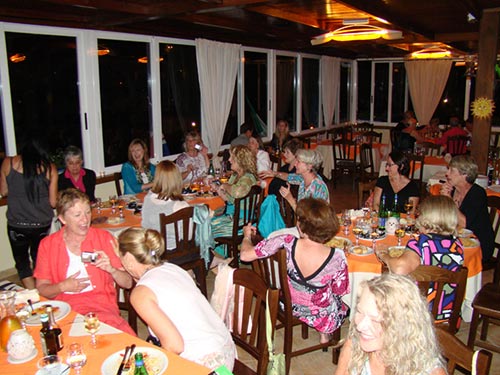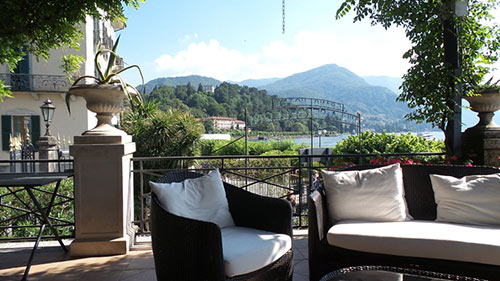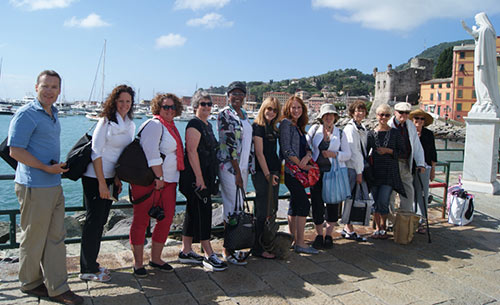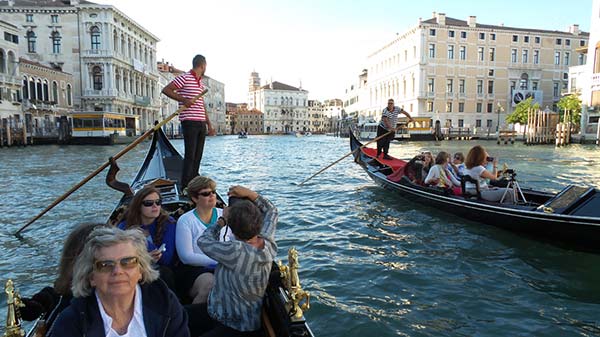This is the last in a three-part series in which Cindy Briggs and Theresa Goesling share their expertise on running painting workshops. In the first installment, we explored the planning and preparation of a workshop. In Part II, we looked at marketing. Part III, below, examines the execution of a successful workshop.
Lead Image: Plan field trips, and have others in mind should budget and schedule allow you to add them.
The duo, two artists who run a company called Make Every Day a Painting Workshops, stress one thing above all else when it comes to execution: customer service. “That has to be the priority,” says Briggs. “The workshop is about your clients — not about you. They need to feel from the very beginning that they are welcome and that they are going to be taken care of. The clients need to feel confident about what is going to happen when they are there. Often, artists don’t provide enough info to create this confidence.”

However, workshop organizers need to know what to hold back and not mention to the participants. This serves two purposes: so if time or money suggests sacrificing a planned activity, they aren’t breaking a promise, and so when the activity is added, it’s a fun surprise. This approach keeps a workshop on budget and preserves the confidence a participant wants in the itinerary. “Be clear in documentation so people know what they are getting,” says Briggs. “Don’t be too specific about activities because you may have to change the schedule. We plan so well that we haven’t encountered crises; we put some padding in our budget. We keep track of expenses every day, and we can add on things as a bonus if things are all going well. For example, there might be a train ride that we don’t promise but we add if things are going well. We budgeted for a ferry to Capri from Amalfi, but we found out we had enough money to hire a private boat and get a private tour. And, in terms of budget, we don’t include a lot of meals that raise the price. People get tired of late dinners anyway.”
Encourage independence. Briggs says they provide a short guide to the local language, and they involve the concierge in planning and orientation when possible. Before the participants even arrive, Goesling and Briggs make sure that each client knows a backup plan in case travel arrangements go awry. “We have made sure they know how to get to us in case they missed the bus, for example,” says Briggs. “Get them to the location somehow, no matter what.”

Upon arrival, clients benefit from an updated, detailed itinerary, and a meet-and-greet with other participants. Briggs and Goesling have confirmed the ferry schedule and have “the field trips nailed down.” They have bottled water, name tags, and information on things like the closest ATMs. They encourage budding friendships, and mention events such as concerts, regattas, and the like that offer opportunities to socialize. Briggs and Goesling also start assessing the group. They try to discover the goals of each participant for the workshop.
And they try to find The One.
“Yes, there’s one in every group,” laughs Briggs. “Some people just have that personality. We try to figure it out early on. We spend one-on-one time with each person and try to pick up on those kinds of things. Usually we can intuit who The One is and really warm up to them, and try to nip it in the bud. Also, there will always be that person who doesn’t show up on time. So we call them, knock on their door, give them lots of notice. When encountering the difficult and annoying, give them as much positive energy as possible to help them. And try to help those who are struggling with their painting, but be careful about making marks on their canvases. They may want you to fix their paintings every day.”

The duo recommends that the first day of the workshop stay simple and easy. “You want a successful, easy day, not far from the hotel,” says Briggs. “Make sure they are happy and feel confident.” For the rest of the workshop, the teachers make sure that the painters are comfortable. Painting spots must have shade on hot, sunny days. Bathrooms and water must be available. “If people are comfortable, they are generally pretty happy,” says Briggs.
Goesling and Briggs make a point of taking a photo of each student while they are painting. After the workshop, they e-mail the photo and a group shot to each student, along with a synopsis of what they did each day. “We keep notes on that,” says Briggs, “And we ask for quotes that we can share for future workshops.”
But they don’t encourage participation in social media while on the workshop. Briggs says there are security reasons why people shouldn’t advertise that they are overseas for a week or more. Afterward, they suggest that participants post photos on Facebook and tag everyone.
In conclusion, Briggs says that workshop organizers need to be adaptable and vigilant. “You must be flexible,” says Briggs. “In case of bad weather or an unexpected event, you need to be ready to go with a backup plan. And don’t lose anybody! Be very careful about meeting times — keep them constant. That helps you keep track of everyone.”




